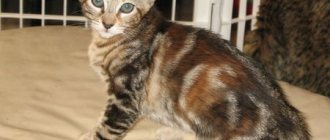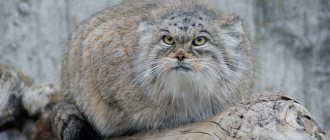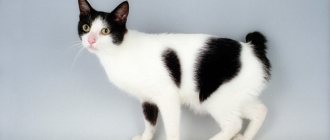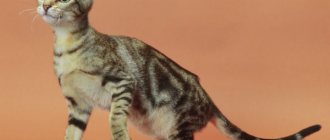- Pets
- >>
- Cat breeds
* Here is a photo of a typical representative of the Serval cat breed . You can send us photos of your animals by email, and we will post them on the website. Don't forget to send your pet's name.
Other breed names:
Bush cat
Video
* We invite you to watch a video about the Serval . In fact, in front of you is a playlist in which you can select and watch any of 20 videos about a given cat breed by simply clicking on the button in the upper right corner of the window. In addition, the material contains quite a lot of photos. By looking at them you can find out what a Serval looks like.
In this article:
|
Rate the material!
[Total votes: 2 Average: 2.5]
The Serval is a beautiful member of the feline family that can make a very affectionate pet. Raising Serval cats as pets is a great experience for avid cat lovers. But servals have very different behavior than the domestic cat and have special care requirements. To start a life together, you need to understand the nature of the “African serval”.
Domestic servals
The Serval cat breed appeared at home quite recently. It turned out that these wild predators, under certain conditions, can easily live next to a person, becoming a member of his family. Moreover, they are able to interbreed with domestic cats and even with caracals.
A large Serval cat gradually began to fill apartments and estates. It happened spontaneously. A wild kitten was simply brought back from travels in Africa and raised as an unusual domestic animal.
Despite the fact that the serval has almost become a domestic cat, there is no standard for such a breed yet. However, work in this area is ongoing, and a description of the new domesticated cat is already available.
This breed can be characterized as follows.
Body dimensions. Compared to ordinary domestic cats, servals seem like giants. As mentioned above about the wild inhabitants of Africa, these cats are more than a meter in length. At home, the size can be larger, if, of course, they are fed and treated well.
Head. Relatively small, but the ears are very large, set high, equipped with fur on the inside, and painted with black and white stripes on the outside. Despite the elongated shape of the muzzle, the nose and bridge of the nose are wide. The eyes, even for the cat family, are extremely almond-shaped. This still wild, genetically completely undomesticated graceful cat has the characteristics of an ideal hunter. In particular, it has well-defined vibrissae as a special sensory organ. They are long, clearly visible and very dense.
Legs. People are attracted to these cats, first of all, by their wildness and unusualness. However, one of the most interesting characteristics of the animals is their long legs. Their hind limbs are noticeably longer than their forelimbs. In natural conditions, such proportions allow you to make a big jump. Servals, of course, are not cheetahs; they cannot run a lot or quickly, but they manage to make a rapid dash for prey perfectly.
History of the origin of the serval
The name "serval" is the Portuguese name that Georges-Louis Leclerc, Comte de Buffon, used in 1765 for a spotted cat that was kept at the Royal Menagerie at Versailles at the time. The name Leptailurus may have come from the Medieval Greek λεπταλέος or λεπτός, meaning "beautiful, subtle". Serval cats have lived with people since the ancient Egyptians and were often used in their drawings. However, they were not domesticated.
The world first heard about this living creation of nature from the scientist Schreber in 1776, and over the course of approximately 80 years, several other subspecies were discovered. Already in 1858, an official scientific classification was created, which stated that this cute kitten belongs to the mammals, carnivores, cat families and belongs to the serval species.
Fun fact: Research conducted in the 2000s and 2010s suggests that the serval, along with the caracal and the African golden cat, forms one of eight lineages of cats. According to a 2006 genetic study, the origins of the Caracal date back to 8.5 million years ago.
The serval cat is native to Africa, where bushes and tall grass provide maximum camouflage for the animal, allowing it to sneak up on its prey. Originally found throughout Africa, wild populations are now primarily found in southern Africa, Zimbabwe and Natal. Small groups are found in the Atlas Mountains. Servals have also been found in Algeria, Ethiopia, Morocco, and sub-Saharan Africa. Thanks to translocation, members of this species can now be found in northern Tanzania.
Serval cats make different sounds:
- High-pitched cry to call other individuals;
- Growl;
- Spit;
- Purring and much more.
To see this amazing creature in its natural habitat, you need to travel a little. The range of these large cats is quite large, but this eccentric is a rather secretive animal. Having the longest legs of all cats, servals are very agile jumpers and skilled hole diggers. They can catch birds taller than 2.7m in the air and dig up to a meter to get under a fence.
Origin and popularity
Servals were not immediately tamed and domesticated, and today these amazing creatures live in the wild. Egypt in particular, and a significant part of the African continent as a whole, can safely be considered their homeland.
In ancient Egypt, cats were always revered, but servals were very popular because of their hunting talents - where these bush cats appeared, snakes and rodents immediately disappeared. This is confirmed by many figurines and drawings with images of this cat found by archaeologists. Previously, they lived throughout Africa, and now they live mainly in the southern part of the continent (the largest number is in Tanzania).
The first mention of servals dates back to 1765. Then the famous Count Georges-Louis Leclerc described a large golden cat with distinct spots and stripes, which was a pet of the Royal Menagerie of Versailles.
The Serval breed got its name from the Portuguese name, but the nickname “bush” cat is due to its place of residence, since the animals try to hide in tall bushes. This helps to hide from larger predators and easily sneak up on prey.
If we talk about the domesticated serval, as it is known now, the breed was registered in the middle of the 19th century. They were owned exclusively by wealthy families throughout Europe, because they were a sign of high taste and even luxury.
It is difficult to distinguish wild animals from domestic ones by external signs; this is where habits come into play.
Serval - description of the breed
Adult servals are slender, agile animals, approximately 60 cm long from shoulder to tail. Males weigh 9 - 18 kg, and females 9 - 13 kg. Thus, they are almost 20 cm taller than South American ocelots, which have a similar body length, and about 30.5 cm taller than the caracal, which has a similar weight. The serval has a small head with large round ears. The legs are very long: in the entire cat family, no other species has such long legs in proportion to the body. The tail is of medium length, reaches forty centimeters, the body is very slender.
Fun fact: Servals resemble cheetahs, but have a shorter tail than their cousins. As a rule, they hunt near cover to quickly hide in case of danger and stay close to water. In the wild, they are solitary and occupy an area of four to 20 km². African serval cats are not listed as endangered.
Their legs and ears are considered the largest in the cat family. The serval is similar to the sympathetic caracal, but has a narrower footprint, a rounded skull, and no prominent ear tufts. It resembles a cheetah in structure and coat pattern, but not in size. The serval is similar in adaptation to marshy habitats with the jungle cat. Both cats have large, pointed ears that help locate prey.
In April 1986, the first Savannah cat was born, a cross between a male Serval and a domestic cat. The specimen was larger than a typical domestic kitten and resembled its father in its pattern. This cat breed has the habit of following its owner like a dog and can be a good swimmer. Over the years, the hybrid has gained popularity as a pet. The Savannah may be a better option than the Serval for people who like the appearance of the animal but want a more docile pet that is easier to care for.
Feature of the breed
The skin of a serval is of some value. Original dark stains and lines on the yellowish background of the animal’s fur, black spots of various shapes and sizes randomly located on the cat’s body give it a magnificent appearance. The western part of the continent, due to the dense population of people, has become an incredibly dangerous territory for the serval, where he is awaited by hunters who mercilessly kill for the sake of exotic fur.
It is worth noting that of the 14 species, the most interesting representatives of the breed are the absolutely domesticated ones, since only thanks to the painstaking work of breeders, white individuals with silver spots on the skin in the form of spots were revealed to the world. Nevertheless, in specialist circles it is the pristine beauty of the breed that is valued, which determines the purity of the species and its “naturalness”.
Popular serval colors
Servals are tall and slender animals with noticeably large ears. Proportional to their body size, they have the longest ears of any wild cat. The back is darker. The base coat color is sand to copper with black or dark brown spots and a striped pattern. The belly is light beige to white. The pattern is unique for each individual.
Black spots and stripes on the body vary in size and location for each individual. Individuals living in African grasslands have larger spots than those found in forests. The markings run from the top of the head between the ears and continue down the back, breaking into four distinct lines. Having reached the shoulders, the lines break and are scattered into spots along the same path of the stripes.
Interesting fact: In the early 19th century, taxonomists believed that small-spotted and large-spotted servals were different species. In the highlands of East Africa, such as the Aberdare Mountains in Kenya, there are also all-black servals, which were also originally considered a separate species. Most of these melanists were seen at altitudes from 2440 m to 2745 m. But snow-white individuals with silver spots were bred by breeders.
Reaching the rear, the spots extend perpendicularly and form rings on the tail. The tip of the tail is black. The back of the ears is black with a white line between them. Melanistic servals are occasionally observed. The Serval has great individual differences. For example, there are servals with very small spots, while others have large spots.
Appearance and features
Photo: Serval animal
The serval is a wild cat of amazing beauty. External characteristics are similar to a lynx or a golden cat. They are also similar to large, robust and strong house cats. The body length of one adult individual is 80-140 centimeters. The height of the body at the withers is 40-70 centimeters. The body weight of an adult is 18-22 kilograms. The animals have a small but thick tail, the length of which is 20-35 centimeters.
Servals have a small head relative to their body size. The muzzle looks like the muzzle of a lynx. Servals have large, long ears, which are considered to be the “calling card” of the animal. They are located high and abundantly covered with wool on the inside. The area of the nose and bridge of the nose are wide, the nose is most often black. The eyes are almond-shaped, very expressive, light.
Video: Serval
These representatives of the cat family have a very flexible, slender and toned body. They also have flexible, thin and very graceful limbs. Among all representatives of the cat family, they have the longest limbs relative to the body. The hind limbs are slightly longer than the forelimbs. These representatives of the cat family have very strong, well-developed muscles.
The coat is short and thick, very shiny. The color resembles the coat of a cheetah. The color scheme is dominated by golden gray. In the area of the neck, chest and belly the coat is lighter, milky or white. Against the background of golden-gray or milky wool there are spots and stripes of black. The color of the coat is largely determined by the region of residence.
Animals that live in the steppes have a lighter color and large spots, animals that live in forests have a darker, almost brown color. There are also black servals that live in the mountain ranges.
Character and habits of servals
In the wild, cats must be smart to survive. Natural selection allowed the smartest and most dexterous individuals to remain alive, and you will understand this when the serval suddenly learns to open doors. The animal has a shy and fearful behavior, but it is very active and playful.
Some of the natural tendencies of servals are:
- One reasonable factor is that feral cats will run away from danger. If a serval is chased, the animal will think that you are trying to harm it. There is no need to follow this cat unless absolutely necessary. But even in an emergency, you should try to get your serval to come to you by cooing or talking to your baby serval, playing with his favorite toy, or offering him a treat. You will be more successful;
- Adult servals are wary of strangers. In the wild, when an unknown male/female feral cat enters another's territory, a challenge usually occurs, or one of them runs away. When visitors come to you, the serval may hide and not come out until he is sure that the guests have left. Do not try to exhibit a serval for show. This will frighten your pet and may cause emotional/physical harm. They may start to distrust you;
- Be sure to keep an eye on children who are near the serval. If children harm the animal, it may develop a fear of children and servals may attack the offenders. This fear of children will remain with them forever. They are very smart and can distinguish the voice of a child from the voice of an adult;
- Servals generally love other animals. They can play with almost any animal once they get used to each other. However, as your cat gets older, you need to be careful when introducing her to a new small pet. They may think that they are chewing toys and causing pain to the baby.
Don't forget that although the animal lives next to you, it should also have its own cozy nest. For this reason, it is useful for him to create a comfortable, soft place where he can retire, sleep or just lie down.
Interesting facts about servals
These cats are slender but strong. Their name comes from the Portuguese word meaning "wolf-deer".
Let's find out what is remarkable about a small cat:
- Servals are long-legged, which is why they got their nickname “giraffe cat.” Much of their long-leggedness comes from the elongated metatarsals of their legs;
- The largest ears among cats. On top of their small heads are sickle-shaped, tall oval ears, black on the back with a characteristic white spot. If people had ears like servants, they would be as big as dinner plates;
- Servals jump high. When hunting, they make high vertical leaps into the air;
- Both males and females mark their territories by spraying urine onto trees and bushes, rubbing fresh urine into the ground with their claws. Males do this more often, spraying liquid up to 46 times per hour or 41 times per km²;
- Servals engage in cat fights. Threats can look scary: cats straighten their ears, arch their backs, bare their teeth and nod their heads enthusiastically. If the situation escalates, they lash out with their long front legs and bark and growl;
- Servals purr. In addition to barking and growling, the serval can purr, chirp, hiss, giggle, grunt and meow. Listen to the sounds on the video;
- Servals can live more than 20 years. Life expectancy in the wild is 10 years;
- There is a serval-domestic hybrid cat. It's called a savannah, and it's a cross between a serval and a regular house cat. This breed was recognized by the International Cat Association in 2001.
Serval at home
Attempts to domesticate servals have been known since the times of the pyramids. But later the connection between people and bush cats was lost. Interest in the serval arose again in the 20th century. Perhaps the animal was originally seen as a source of exquisite fur. Secondly, as a pet.
The main efforts to breed and obtain a domestic version of the Serval were made by breeders from the USA. Multiple experiments were conducted to breed hybrids. Although the serval in its original form is quite suitable for keeping at home.
Today, servals are recognized as pets. Genetically pure representatives are not considered a cat breed. At the end of the 20th century, a hybrid of the serval and the Siamese domestic cat became widespread. It was called Savannah. The cat was registered by the International Cat Association as an independent breed in 2001. In 2012, the association recognized this breed as a champion.
Now she can exhibit and compete at the highest, international level. The breed, based on a hybrid of a serval and a shorthair cat, appeared around the same time as the Savannah. The breed received the name Serengeti. Recognized as independent.
These two hybrids are the most popular among hobbyists and therefore breeders. The breeding center is the USA. Cat owners are attracted to the qualities derived from the breed's founders, the Serval.
- Beauty, grace and nobility of appearance.
- Friendliness and affection, like an ordinary cat.
- A dog's devotion to its owner.
- Intelligence and flexibility during training.
- Good health.
The domestic serval has not only advantages. There are disadvantages that can make you decide not to own a luxury pet.
- The animal's intelligence is combined with cunning and stubbornness.
- Any smaller pet can become a victim of a serval.
- The urge to move, jump, and climb is higher than that of ordinary cats.
- The territory that the animal considers to be its own can be marked.
- The price of domesticated servals is very high.
Servals, Savannahs and Serengetis are kept in the same house as regular cats. They require the same amount of attention, more space and a more lenient attitude towards damaged furniture.
Feeding domestic servals does not cause any particular problems. Raw meat with bones is the basis of the diet. Beef, poultry, offal are suitable. Supplements of vitamins and microelements are required. It is possible to switch to dry food. In this case, it is better to consult a veterinarian.
Monitoring the animal’s health is standard: you need to get vaccinations in a timely manner, monitor the animal’s mood and behavior, and contact a veterinarian in alarming situations.
Most often, cats are kept as companions, not as breeders. Therefore, to make caring for a serval , it is better to sterilize the animal. This simple operation for cats is performed at the age of 7 months. Cats are operated on when they are one year old.
Pros and cons of servals
Living with such a miracle of nature as a serval under one roof is a pleasure. If you bought a small kitten, there is no particular need to equip it with a cage or enclosure. His behavior is not much different from ordinary kittens, and he feels very comfortable in the apartment. Only such an unusual pet needs to be raised from early childhood. This is necessary so that as he grows up, he still perceives you as his best friend.
Advantages of the breed:
- The special beauty of the animal;
- Balanced temperament, absence of causeless aggression;
- The serval is a very loving and devoted animal;
- Has almost dog-like habits (fetching balls, toys, fooling around) but moves around the house much more gracefully and accurately;
- Good health;
- Trained and performs even complex tasks;
- Friendly towards other pets at home;
- There are no hereditary diseases;
- Easy care.
Flaws:
- Servals are sometimes stubborn; you need to point out the limits of what is permitted;
- They jump on high furniture;
- A lack of toys leads to damage to objects around;
- Often everything overturns;
- Needs a lot of personal space;
- He responds to screams and force with aggression;
- Marks territory;
- High price.
The best weapon against bad behavior of a serval, as strange as it may sound, is a simple splash of water. In case of bad behavior, simply spray some water on your pet and explain to him that it is bad. He will hear and listen to you. In general, these cats are very smart and if you repeat the same remark to him several times, he will definitely understand.
Serval breeding
African servals are solitary animals, except during mating periods. They are polygynous, and the territories of males in the wild overlap with those of as many females as possible for optimal breeding. Although there is no set breeding interval, mating occurs more frequently in the spring. A female almost ready to breed will hunt and court a male for several days just before entering estrus. Estrus can last only 1 day.
Breeding in captivity is controversial. It must be based on knowledge and experience. In the world of wild cats, the birth of babies is a real miracle. The babies that are born are very welcome. After a short gestation period of 10 to 11 weeks, females give birth to 2-3 kittens. These young individuals weigh about 250 g at birth and double in size in the first 11 days. Permanent canines develop by 6 months. Sexual maturity occurs between 18 and 24 months.
Interesting fact: Serval breeding challenges breeders because... The Serval is not “created for breeding in captivity,” but these cats can produce offspring in a home environment. During the breeding season, the animal becomes restless, excessively active and can injure other animals. Kittens may be born immature and often require human assistance if they are to be viable at all.
However, if a serval cat carries hybrid offspring after mating with a regular cat, there is a risk that she may kill the tiny kittens. Hybrid kittens weigh only 90 to 110 grams. By the way, male descendants resulting from crossing will remain infertile for three generations. If higher maintenance males are found to be fertile, they often have small litters and remain sterile for a short period of time. As they remain in captivity for several generations, mating efficiency becomes higher.
Caring for Servals
Servals are by nature living creatures with remarkable intelligence, and it is not difficult for him to explain the basic intricacies of apartment life. First, you must train your exotic pet to fulfill the need for a litter box. These little animals are very clean, so you won't see much resistance in this training. However, they do not always bury their excrement like regular cats. In addition, servals mark their territory. To prevent unpleasant odors in the home, it is better to spay or neuter your animal.
Teach your pet to trust you. When you try to make friends with a serval, feed them directly from your hands. This will start trust. They know you are giving them something good when you reach out to them. Another way to bond with a serval is to lie on the floor with the cat and their favorite toy and play with them.
When you're on the same level, cats feel at ease and will soon feel comfortable with you, whether you're standing, sitting or lying down. You need to be patient, because... This may take some time. Never yell at a serval. Never force yourself on them. And never hold them in your hands against their will. They will learn to run away from you rather than come to you.
Interesting fact: This friend can be taught a collar and leash from childhood, he will happily walk with you on the road. Just remember to free the animal from the leash immediately after a walk, because a serval can not only injure itself while playing with the collar, but also suffocate.
The Serval needs personal toys to keep important things in the house safe and sound. The thing is, this little furbaby loves to chew on everything and if he doesn't have anything handy, your books, clothes and cables will become play items, and it's not only your loss, it's deadly for the cat. If your cat is focusing its attention on an object in your house, you can spray it with apple spray, the scent will keep it away. Such repellents are sold in every pet store.
Servals in your home ®
Sections of the article:
- Our training
- brief information
- Choosing a kitten
- Feeding servals
- Feed quantity
- Breastfeeding the baby
- Tummy massage
- Kitten stimulation. What is it for?
- Character and behavior of servals
- Once again about the marks of servals
- Socialization of kittens
- Games and toys
- We are in the media
Author: Anna Kuzmina Date: 08/01/2012
We completed the full European seminar “Small cats: Serval, Caracal, Ocelot” and received European certificates on the following topics:
- Legal basis for keeping, breeding and commerce.
- Basics of animal care.
- Historical origin.
- Natural habitat.
- Interaction and approach.
- Diseases and their prevention.
- Nutrition.
- Reproduction.
- Arrangement of a warm room and construction of an outdoor enclosure.
- Practicing in practice.
We deliberately do not post certificates and documents on the VIPLEO website to prevent copying. We provide our customers with the opportunity to study all our original documents confirming the legality of the acquisition, breeding and commerce of our animals.
We provide our customers with recommendations on maintenance, upbringing, nutrition, vaccinations, and reproduction (if the animal is purchased for breeding). All kittens are raised professionally and with great love!
Brief information note
The genus Serval belongs to the subfamily of small cats the cat family , and is directly related to big cats with their famous representatives - lions, tigers, leopards, etc.
Along with the serval , this group also includes other more famous cat species, such as the ocelot, the caracal or the African wild cat, which is considered the ancestor of our today's domestic cat.
Like the wild cat, the serval has long been recognized by people as an amazingly beautiful, graceful and useful pet.
It is thanks to their friendly behavior, similar to that of a dog, and hunting for pests (mice, rats, etc.), that these animals have long and firmly taken an honorable place among beloved and useful pets.
I would like to draw special attention to the fact that Servals are very friendly and not dangerous to humans.
Choosing a kitten
In order for a kitten to be tame, kind and affectionate, it must be purchased from home-type nurseries, and not from establishments with enclosures.
From 2-3 weeks of age, a serval kitten must be in constant contact with a person, otherwise it will grow up wild, and it will be impossible to accustom it to living together in a house with people.
to buy a serval kitten when it can eat meat on its own, is toilet trained and has received all the necessary vaccinations.
I do not recommend buying a kitten before 8 weeks, this is a big risk. You must immediately determine for yourself whether you are purchasing a kitten for breeding or as a pet. If it is a pet, it must be neutered on time, preferably at 5-7 months - otherwise there will definitely be problems with marks. Although, castration does not guarantee that a serval (female and male) will not mark territory. If an animal is purchased for breeding, be prepared for the animal to begin marking its territory - both males and females.
Do not purchase animals from “resellers”; they often purchase animals from “illegals”, poachers or from zoos, without having an official package of documents. And from this it follows that the animal will be socially unadapted, not toilet trained and, possibly, sick.
Such animals are absolutely not suitable for living in a home, especially if there are children in the family.
The absence or partial absence of the necessary documents issued by official State bodies for the acquisition, maintenance and origin of this type of animal is prohibited by law.
Such an animal is subject to confiscation. Remember that the Serval is listed in the International Red Book (category II) as a “endangered species.”
Do not purchase a serval if your children are under 5 years old or if your child has not yet learned to handle animals well.
Do not purchase a serval if you have a small living space.
It is ideal for a serval to live in a private house with an attached enclosure with free access to it. The minimum size of the enclosure is 15.0 sq.m., height 2.5 m.
Feeding servals
The Serval is a predatory cat and needs appropriate and special food in order to receive all the vital components.
There are various options for feeding the serval : chicken, beef, poultry (game), mice and rats, rabbit, fish, frogs, and sometimes raw eggs. You can also use high quality cat food. Under no circumstances should you feed raw pork. This can lead to Aujeszky's disease, which can be very dangerous for the cat. Salt and spices should not be added to the diet. Follow a varied and balanced diet. For 3 years, the serval needs to be supplemented with vitamins and calcium.
Feed quantity
An adult serval needs to receive about 3-5% of its body weight in meat every day. Thus, the daily dose of meat from a 10-kilogram serval is 300-500g. Serval may need a larger dosage during the growth period.
On very hot days, the cat's appetite is often not great, while in the cold season it is much better.
As a rule, there should be one or two feedings per day. Feeding should not be done at the same time every day, as animals get very used to this time. The Serval should feel hungry occasionally and should never have constant access to food, as is common among some cat owners.
The meat should be at room temperature. What was not eaten must be removed after feeding. Possible food residues should also not be left behind. For adult servals, it is advisable to do one day of complete fasting every 8-14 days.
Feeding a baby serval
In order to raise a healthy, strong and loving Serval kitten, you need to invest a lot of time and knowledge into this process.
Serval puppy from VipLeo cattery | Grandchildren of VipLeo nursery |
The health of a kitten directly depends on the quality of the milk consumed, which must be supplemented with all the necessary vitamins and minerals. In this case, the milk must be at the correct temperature, and the amount of serving is also important. If you do not adhere to these rules, the kitten will grow up with signs of rickets and other diseases that will affect themselves over time in adulthood. Therefore, it is very important to establish good health and development from a very young age.
Tummy massage
Why do caracal and serval kittens have their tummy massaged since childhood?
Due to the fact that the kitten is bottle-fed and the cat mother does not have access to lick the kitten’s tummy, the human mother should take on this role, massaging the baby’s tummy as often as possible. In order for the kitten to go to the toilet well and regularly, and for its gas to pass, this procedure is only to help the kitten. This process also helps to establish contact between a person and a kitten; the baby completely trusts the person, relaxes and often falls asleep in his arms. I adore this procedure, I get great pleasure from it myself, and when the kitten falls asleep I try to put everything aside, sit and take care of his sweet sleep.
Kitten stimulation. What is it for?
The main task of a responsible breeder is to raise a healthy and at the same time affectionate kitten who loves a person. To do this, you need to take the time and take him away from his mother at the right moment, start feeding him with high-quality, correct milk every two hours, increasing the interval over time.
During this period, the kitten still does not know how to urinate and defecate on its own. And the breeder, his human mother, must teach him this. Only after a month does the kitten begin to urinate on its own and then defecate. Until this moment, mandatory stimulation of kittens is necessary. The video shows an example of stimulating a kitten.
Character and behavior of servals
The owner must take into account the fact that Servals are playful, sociable and intelligent animals.
Playing with a serval is both communication and education at the same time. Hunting games with pendant and ball are always a favorite. Classes can last as long as they are interesting for the servals . They love to swim, run after a ball, bring it to you, and walk well on a leash.
In character and play they are similar to dogs, but at the same time they have the gracefulness of a cat. They purr and lick at the same time. Their meow sounds like the pleasant and quiet chirping of a bird. When servals run up, they breathe rapidly with their mouths open, like dogs. These animals are suitable for both cat lovers and dog lovers.
It is for this extraordinary disposition, which is characteristic of both cats and dogs, that they were nicknamed “cat-dog.”
Servals to the toilet in a tray, leaving excrement on the surface of the sorbent, without burying it like domestic cats.
Our servals sleep on the beds with us and with the children. They are not aggressive even towards strangers. But if the cat is used only to its family and has no experience communicating with other people, it most likely will not fall into their hands.
The serval will get scared and run away, but if you drive it into a corner, it will start to hiss. If after this the stranger does not retreat and continues to reach out to the serval , the cat will begin to fight back with its paw. The animal itself will never rush at a person.
If you want him to communicate without problems with strangers, he needs to be accustomed to society from childhood: communicate and play with different people as often as possible. They get along well with domestic cats and dogs.
A serval cannot be forced or punished to do anything. This is a very smart and noble animal and will remember the insult all its life.
Once again about the marks of servals
This is one of our few servals sold as pets. He grew up as a very affectionate child, loved to sit in his arms, and was caressed and rubbed against his legs all the time. Castrated around 4 months. Until 1.4 years everything was fine, but nature takes its toll and with age - during puberty, the serval began to mark. Fortunately, he lives in a private house and you can give him a separate room and an enclosure for walking... I’m even afraid to imagine what would happen if he was sold to an apartment!!! I conducted a survey of many people whose servals (females and males) live as pets/neuters; they were purchased from different sellers and, unfortunately, many were sold to apartments. This saddens me very much, since the marks of servals are not comparable to those of ordinary cats...
I decided to write this post after two people approached me over the last month with a request to place highly marked servals/neuters somewhere. People really can’t live in apartments with them anymore. We kindly ask that if you want to take a serval into your apartment, study this issue and be prepared for the fact that castration may not solve problems with markings. Believe me, servals have no place in apartments! Only at home with the ability to create the right conditions. And you need to realize that the cat can still start marking at any moment.
Socialization of Serval kittens from birth
I’ll tell you a little about the need for early communication between a kitten and a person.
If possible, it is best to make contact from the first days of life. But if the mother cat does not allow access to the kittens, then - from the moment the kitten is transferred to a bottle (feeding by a person, with milk from a bottle). On average, this occurs from 10 days of age (plus or minus 2-3 days). From this moment on, the human mother takes full responsibility for the kitten’s life: she feeds, massages the tummy, stimulates the toilet, carries in her arms, and teaches. And all this 24 hours a day, seven days a week! By the 4th week of life, it becomes easier, since the break in night feeding increases and you can sleep for about 6 hours.
In our family, our children know how to feed kittens. This is very helpful when there are many kittens in a litter or several litters at the same time. Having prepared the right amount of milk at the right temperature, my children and I feed several kittens at the same time. It is also very important that our children help a lot in the socialization of kittens; they know how to properly handle them at this young age. Therefore, by the time the kittens are handed over to the buyer, the kittens are not afraid of humans, but on the contrary, they trust him, love him and always follow him. Proper socialization of kittens from a very early age is the main thing, without which a caracal or serval will not grow up who will love and are not afraid of humans.
Games and toys
It is necessary to ensure that toys do not pose a danger to the health of the animal. Most ordinary cat toys are not suitable for the serval ; they are very small and fragile for them. Plastic and foam balls are dangerous because parts can be swallowed. It is better to take durable and natural dog toys.
One rule applies to all games: toys are provided only for a while, then they are hidden - otherwise interest in them quickly disappears. Servals are very curious and therefore are always happy if something new appears for exploration. After a couple of days, old toys become new and interesting again. You should only play with your serval with toys, not with your hand or foot. Hands are only for affection!
We are in the media
TSN, UA — Koshenya vartistu s car. Channel “1+1” – February, 2019
TSN on channel “1+1” from 02/16/2019. The story is about our VIPLEO® nursery in Kiev and our graduate - a caracal who lives in Kharkov. The other serval in the story that another participant talks about is not our graduate, he was bought from another seller.
Overall, I’m very pleased with the program, it turned out to be short and realistic, without “rose-colored glasses.” The shooting itself was a breeze, it took a long time to film and there was a lot of interesting stuff. Naturally, all interesting shots cannot be included in the news program. You can film and talk about these cats for hours, but airtime, unfortunately, is limited... Thanks to the channel and 1+1 journalists for filming!
For everyone who has expressed a desire to buy a kitten in our VIPLEO nursery , we provide detailed information based not only on our knowledge and our personal experience, but also on the experience of well-known European home nurseries with 15-19 years of experience in breeding servals exclusively in families for living with people.
Copying or partial copying of text and photos is prohibited!
Contacts: (+38)0989668888, [email protected]
Photos of graduates
Back to the beginning of the article
Back to list of articles
Serval diet
Servals need more nutrients than domestic cats. In the wild, servals feed on rodents and small animals, as well as birds. In captivity, the diet must be adequate nutrition. They must receive sufficient calcium (54 mg per animal).
The Serval diet consists of poultry bones, meat and fish with added vitamins intended for wild cats. This includes all shapes of chicken (necks, thighs, wings and stuffing), turkey necks and ground beef, any cut of beef and ground beef, and canned fish such as tuna, salmon, mackerel. You can also offer delicacies such as cheese, beef jerky, fruits such as strawberries, cherries, oranges and bananas, lettuce and tomatoes, and macaroni and cheese.
Serval feeding stages by age:
- Feeding kittens consists of high-quality crushed food. Kittens under 6 months of age will need mince, offered in combination with wet food. A mixture of ground raw turkey mixed with powdered dry IAMS works well for small kittens. You may want to feed them regular cat food, but only use premium cat food that is 75% meat;
- By the time the serval is six months old, it can be fed a combination of dry and wet food;
- As your kitten begins to mature, you can give him a chicken leg or neck. When the serval reaches maturity, he can be offered raw chicken, bones and all. Do not feed your animal cooked meat. Most meat contains high levels of phosphorus, and if not eaten with the required amount of calcium, it will lead to small or brittle bones and other problems. Exotic cats need the correct ratio of the two minerals to use calcium for bone growth. The serval should eat as much as it wants, but don't leave food out for more than a couple of hours;
- An adult eats from 0.5 to 1.4 kg of meat per day. Serval cats can eat a lot in one day and less the next day, but if the pet's appetite disappears for a long time, the animal should be taken to an exotic animal veterinarian. Vitamin supplements are required. Feeding grass once a week for the digestive system;
- Make sure they have enough clean water to drink. Place several bowls of water around the house. Animals love to play in water, so make sure toilets are closed.
Diseases and health problems
Servals are quite hardy, but you need to be prepared if your indoor cat gets sick. To be on the safe side, it is best to take your pet to the vet for regular checkups. Your pet can't tell you what's bothering him, so you need to monitor his condition.
Signs to look out for include mood swings, gagging, diarrhea, and strained urination. Diarrhea in young cats can lead to dehydration within a few hours and may require intravenous fluids. If diarrhea occurs more than twice in a row, it is advisable to take your cat to a veterinarian for a check. Diarrhea can sometimes occur as a result of a change in diet.
There is also regular medical care that is necessary when keeping these exotic animals.
It includes:
- Vaccinations. Serval cats require the same vaccinations as domestic cats;
- Spaying or neutering. Changes are best made between 4 and 6 months. Consult a qualified veterinarian regarding this matter;
- Declaw removal. When keeping Serval cats as pets, the question arises as to whether or not they should be declawed.
You may want to discuss this with a qualified veterinarian. There are opinions both for and against this practice. Some sellers remove the animal's claws before selling the kittens. Remember these are wild cat claws and can cause a lot of damage.
On the other hand, declawing is a very extensive and painful operation for a cat, and there is a risk of infection. Some believe that a domesticated serval, with proper training, can learn to refrain from using its claws.











